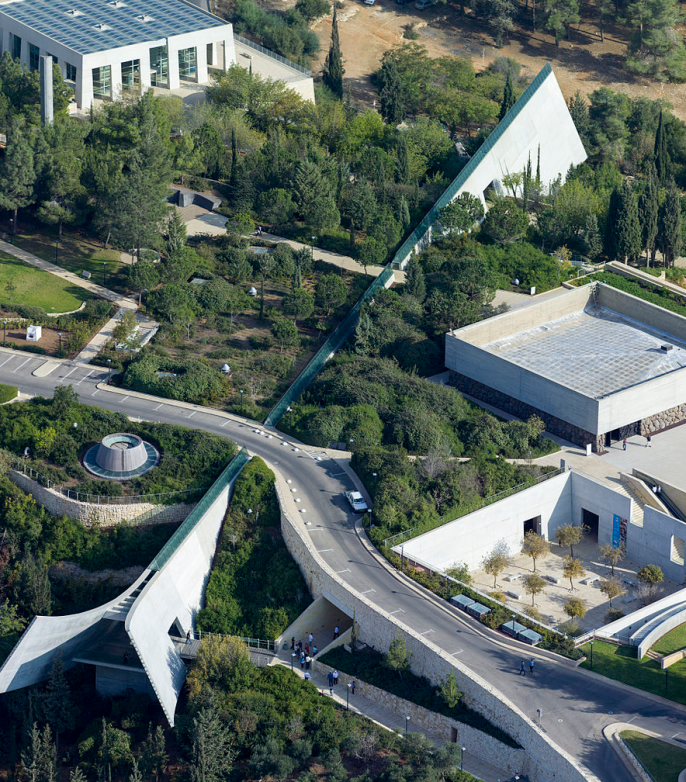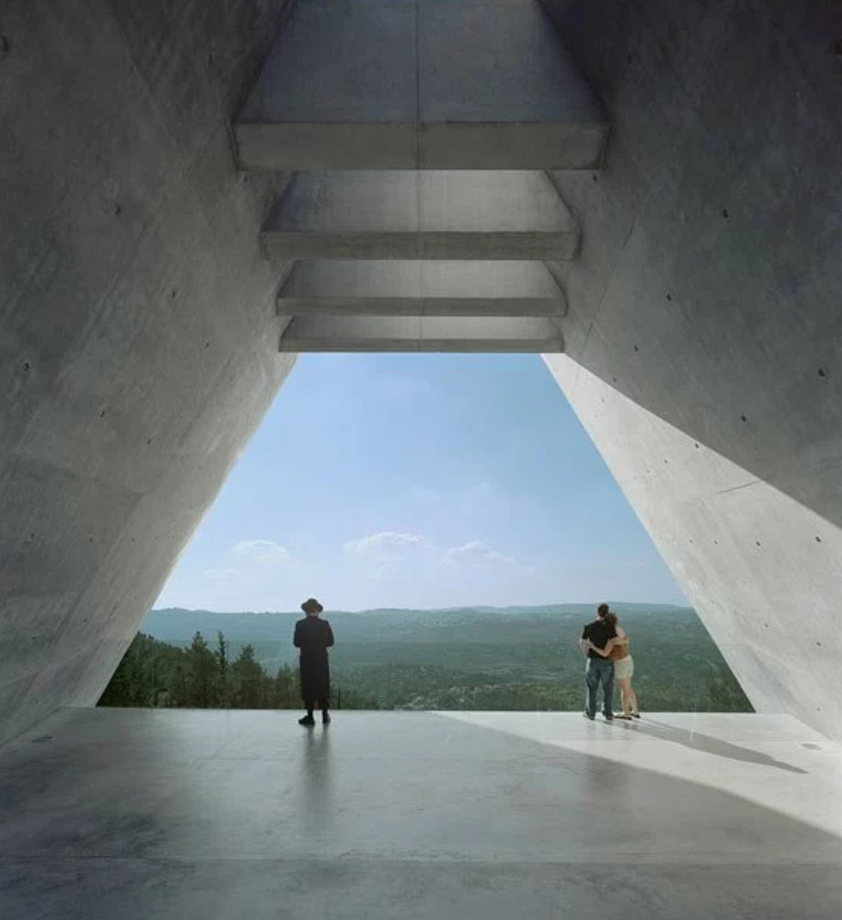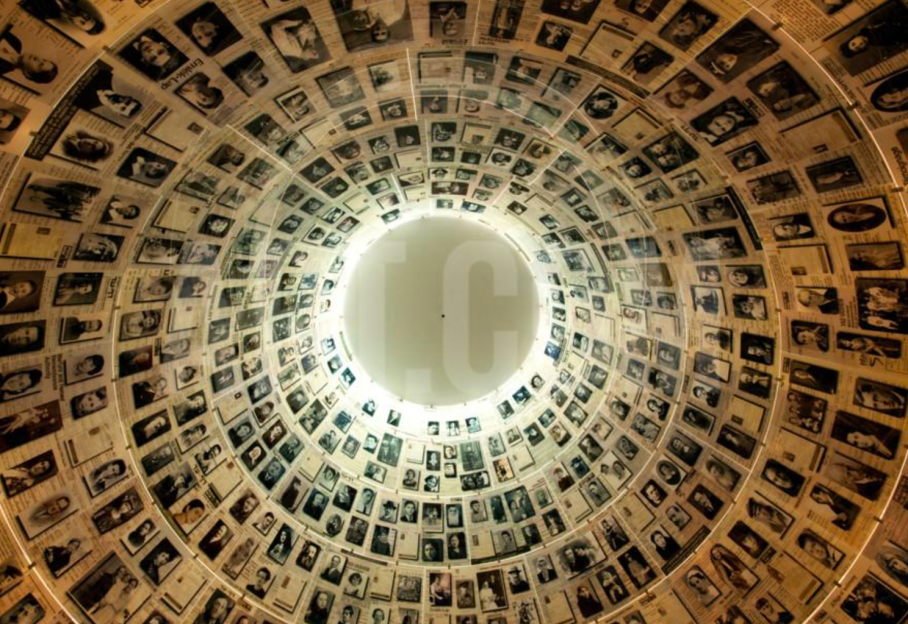Day Ten, Part II – Yad Vashem and Israeli human rights
Day Ten, Part II – Yad Vashem and Israeli human rights
Yad Vashem is impossible to describe – and impossible to forget. The Holocaust, an event so powerful, so transforming deserves a powerful, transforming venue.
Its 180 meters – long linear structure in the form of a spike cuts through the mountain with its uppermost edge – a skylight – protruding through the mountain ridge. Galleries portraying the complexity of the Jewish situation during those terrible years branch off this spike-like shaft, and exit emerges dramatically out of the mountainside, affording a view of the valley below. Unique settings, spaces with varying heights, and different degrees of light accentuate focal points of the unfolding narrative.
The design of the building supports the experience the visitor.
- The main building resembles a long, slender triangular spike, suggesting the nails that secured the rails that carried the Jews to the concentration camp.

- The long, narrow hallway intersects the adjacent exhibit rooms, The visitor walks back and forth through the museum (the transition barriers forcing visitor to walk through each room), duplicating the experience of the Jew of the early to late 20th century, starting with the raise of anti-semitism and ending with a startling view of modern day Israel. The first half of the hallway slopes down and raises towards the end, advancing the sense of both the increasing despair of the Jewish people throughout the Holocaust and then the raising hope with the creation of the Jewish state.

Floor plan

Wire cables guiding the visitor back and forth through the exhibit

End of the hallway
- So many powerful exhibits: The rise of anti-semetism in the 1930s, interviews with individual Jews who experienced various aspects of the Holocaust, artifacts from the time, the Hall of Names, to name but a few.


Hall of Names
As mentioned at the beginning, no amount of words can describe the effect of the visit. The visitor is left with an overwhelming sense of the unimaginable horror of the Holocaust, the incredible capacity of humans for evil, and the undoubtable resolve of the human spirit. Also, it is impossible to understand the commitment of the Jewish people to a Jewish state without an understanding the effect Holocaust (as well as the wide-ranging anti-semitism of recent centuries).
Jewish Institute for Justice
TheJewish Institute for Justice (JIJ) describes itself as “dedicated to cultivating and defending rule of law, human rights, freedom of conscience, and democracy for all people in Israel and its adjacent territories (source). More:
Within Israel, we protect freedom of conscience and advocate for members of ethnic and religious minority groups. We do extensive work on behalf of victims of prostitution and human trafficking, give comfort to Holocaust survivors, advance affirmative action for Ethiopian new immigrants, and provide representation to Lone Soldiers including those who have been abandoned by their ultra-Orthodox families for choosing to serve in the IDF.
While most human rights organizations superficially point to Israel’s occupation of the disputed territories as the foremost abuse of human rights in our region, we espouse a more thorough and balanced view on the matter. We have drafted and disseminated extensive reports on the human rights abuses of the Palestinian Authority (PA) in the West Bank and the Hamas government in Gaza. Our work in this regard has taken us before the UN and European Parliament, as well as to esteemed academic venues on several continents (source).
We met for just about an hour with Calev Myers, founder of the Institute. Mr. Myers immigrated to Israel from the USA in 1992. He graduated from Hebrew University of Jerusalem and became a licensed member of the Israeli Bar Association/

In a wide-ranging conversation, Mr. Myers discussed the following:
- The civil rights work of the JIJ in protecting women, religious and racial minorities, Lone Soldiers (soldiers without relatives), Holocaust survivors WITHIN the state of Israel and others.
- Believes that the Palestinian Authority does not look out for the interests of the Palestinian People in the way it should and its leaders have siphoned millions, if not billions of dollars into their personal bank accounts at the expense of the people they purport to serve (see story here).
- Believes that Israel needs to “look” and “be” strong, and when it appears weak, other nations take advantage.
- He stated that he is an advocate for all oppressed peoples, including Palestinians, who he believes are as oppressed by their Arab brothers
- Mr. Myers believes that the oppression of the Palestinians by Israel does exist!!, but is overstated.
- The UN has an uneven record of supporting human rights, and is driven as much by political concerns as it is interested in advancing human rights.
- Has supported efforts from members of Congress to withhold money the U.S. sends to the Palestinian Authority (about 150 million a year) until their is a full accounting of how those funds are used (link).
The last part of conversation centered around Mr. Myers view of a “solution” to the current conflict. His view involves a modified one-state solution, with the Palestinian enclaves in the West Bank forming a kind of United Arab Eremites (or Swiss Canton) type of federation.
This idea is born out of Mr. Myers’ perception of the “reality on the ground”: Israel would never accept a fully functioning Arab state on its boarders – one with the capacity to form its own military – AND the advent of the settlers in the West Bank. He noted how difficult it was to remove 9,000 settlers from Gaza and that it would be nearly impossible to remove 500,000 from the West Bank. Better to recognize this reality and form a governing body that allow for significant (some??) Palestinian independence and self-rule than to hold out for an impossible second state.
This solution, Mr. Myers believes, would assist the Palestinians in moving forward in their own political, economic, and social development. As long as the Palestinians are “deluded” (his words) into thinking they will be allowed to return to Israel, to the homes they left (no matter the reason for their leaving), they will be distracted from making a life for themselves and their people. Mr. Myers then went on to address some of the other issues related to “right of return,” “citizenship,” and the requirement of nations hosting refugees to absorb them into the life of their country.
Summary
As mentioned earlier, we had spent several days engaged in conversation with Palestinians and their advocates. Dr. Kincaid scheduled these more Israeli-centric events and meetings subsequent to those in order for us to have a better idea of the conflict before we heard messaging that was more familiar to us.
In our debriefs, we discussed with new perspectives some of the issues that have been at the center of our conversation: One-state v. Two-state solutions; the role of ethnicity and religion in nation formation; the extent of culpability in the plight of the Palestinian, and more.
Our heads are spinning – no doubt!! But our hearts are heavy as these issues are more than newspaper headlines to us. We now have faces to put with places and a deeper understanding of the issues. We are (my perspective) rejecting simple explanations of the cause of the conflict and simplistic offers of solutions. This is a complicated place – a place that breaks your heart and taxes your mind. A place with equal parts beauty and tragedy, kindness and contention, grace and violence.
More tomorrow –




